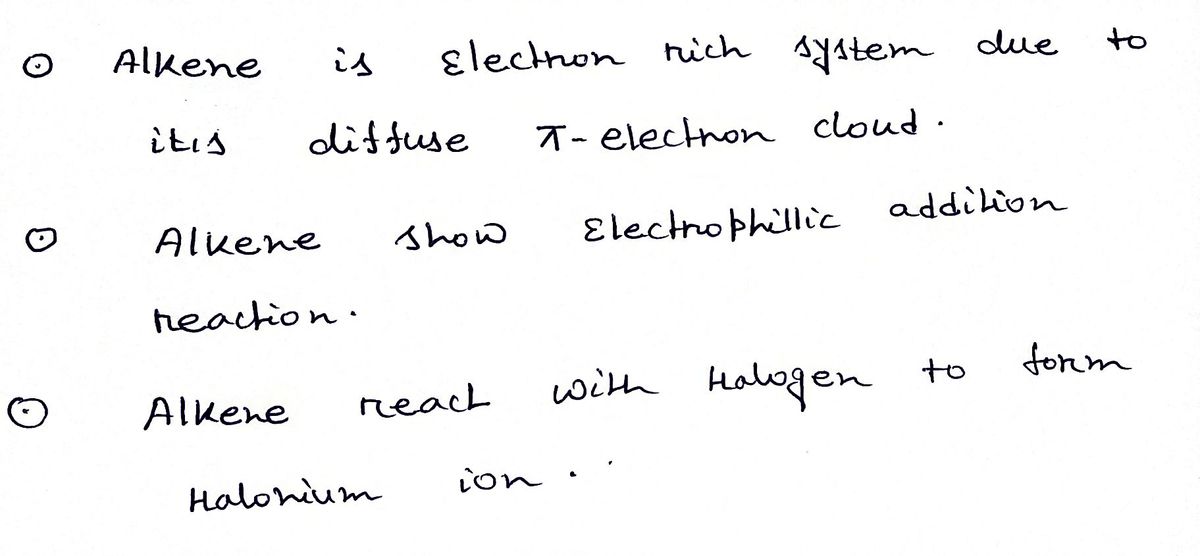Show the mechanism for the given reaction conducted at -5 °C in CCI. cyclohexene + bromine dibromocyclohexane Draw structures, including charges and electrons, and add curved arrows. Details count. Add curved arrows to the first step. Select Draw Rings More C Br H
Show the mechanism for the given reaction conducted at -5 °C in CCI. cyclohexene + bromine dibromocyclohexane Draw structures, including charges and electrons, and add curved arrows. Details count. Add curved arrows to the first step. Select Draw Rings More C Br H
Chemistry
10th Edition
ISBN:9781305957404
Author:Steven S. Zumdahl, Susan A. Zumdahl, Donald J. DeCoste
Publisher:Steven S. Zumdahl, Susan A. Zumdahl, Donald J. DeCoste
Chapter1: Chemical Foundations
Section: Chapter Questions
Problem 1RQ: Define and explain the differences between the following terms. a. law and theory b. theory and...
Related questions
Question
Please label the answers

Transcribed Image Text:**Instructions:**
Draw each species (organic and inorganic) resulting from the previous step. Then, add curved arrows for the forward reaction. Include charges and nonbonding electrons.
**Tools Available:**
1. **Select** - For selecting elements or structures.
2. **Draw** - Activate drawing mode to create structures.
3. **Rings** - Add ring structures.
4. **More** - Access additional options.
5. **Erase** - Remove unwanted elements or structures.
6. **Element Buttons:**
- **C** - Carbon
- **Br** - Bromine
- **H** - Hydrogen
**Line Tools:**
- Single line
- Double line
- Triple line
**Interface Features:**
- Undo/Redo Buttons: Undo or redo the last action.
- Zoom In/Out: Adjust the view scale of the drawing area.
Proceed by using these tools to accurately represent the molecular structures and reaction mechanisms.

Transcribed Image Text:**Problem Statement:**
Show the mechanism for the given reaction conducted at -5 °C in CCl₄.
**Reaction:**
Cyclohexene + Bromine → Dibromocyclohexane
**Instructions:**
Draw structures, including charges and electrons, and add curved arrows. Details count.
**Diagram Interface:**
There is a drawing interface with the following tools available:
- **Selection Tool**: Allows selection of elements or bonds.
- **Drawing Options**:
- Single, double, and triple bond lines.
- Element symbols: "C" for carbon, "Br" for bromine, "H" for hydrogen.
- **Rings**: Options to draw cyclic structures.
- **More Options**: Additional drawing tools not specified in the image.
**Task:**
Add curved arrows to the first step in the reaction mechanism to illustrate electron movement.
Expert Solution
Step 1

Step by step
Solved in 2 steps with 2 images

Recommended textbooks for you

Chemistry
Chemistry
ISBN:
9781305957404
Author:
Steven S. Zumdahl, Susan A. Zumdahl, Donald J. DeCoste
Publisher:
Cengage Learning

Chemistry
Chemistry
ISBN:
9781259911156
Author:
Raymond Chang Dr., Jason Overby Professor
Publisher:
McGraw-Hill Education

Principles of Instrumental Analysis
Chemistry
ISBN:
9781305577213
Author:
Douglas A. Skoog, F. James Holler, Stanley R. Crouch
Publisher:
Cengage Learning

Chemistry
Chemistry
ISBN:
9781305957404
Author:
Steven S. Zumdahl, Susan A. Zumdahl, Donald J. DeCoste
Publisher:
Cengage Learning

Chemistry
Chemistry
ISBN:
9781259911156
Author:
Raymond Chang Dr., Jason Overby Professor
Publisher:
McGraw-Hill Education

Principles of Instrumental Analysis
Chemistry
ISBN:
9781305577213
Author:
Douglas A. Skoog, F. James Holler, Stanley R. Crouch
Publisher:
Cengage Learning

Organic Chemistry
Chemistry
ISBN:
9780078021558
Author:
Janice Gorzynski Smith Dr.
Publisher:
McGraw-Hill Education

Chemistry: Principles and Reactions
Chemistry
ISBN:
9781305079373
Author:
William L. Masterton, Cecile N. Hurley
Publisher:
Cengage Learning

Elementary Principles of Chemical Processes, Bind…
Chemistry
ISBN:
9781118431221
Author:
Richard M. Felder, Ronald W. Rousseau, Lisa G. Bullard
Publisher:
WILEY